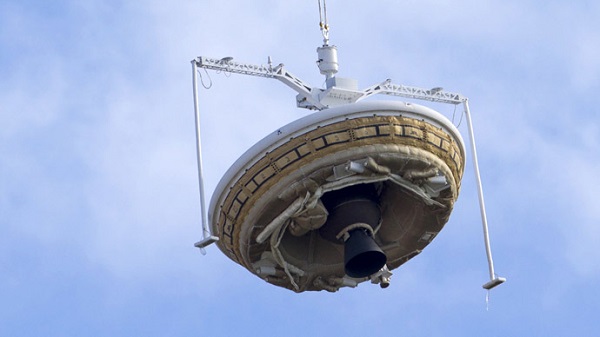NASA's Flying Saucer Tests Landing Technologies For Future Martian Missions
| Kristina Fernandez | | Jun 30, 2014 12:14 AM EDT |
(Photo : Reuters/Marco Garcia)
After several test delays, NASA successfully launched and recovered Saturday a flying saucer sent to the Earth's stratosphere to test prototype landing technologies that may be useful for future martian missions. Despite its chute failing to fully deploy, NASA declared the Low Density Supersonic Decelerator's maiden flight a success.
Like Us on Facebook
According to the space agency, the saucer-shaped spacecraft ascended to 120,000 feet over the Pacific from the US Navy's facility in Kauai, Hawaii, dangling from a helium balloon the size of a football stadium.
The spacecraft then detached from its balloon, igniting the rocket attached to the saucer to propel it to a supersonic ascent of180,000 feet before deploying its breaking system. The vehicle splashed back down in the Pacific Ocean after the giant parachute designed to slow its fall failed to fully unfurl.
The thin atmosphere in the red planet makes landing delicate equipments very challenging. LDSD systems are being developed to slow Martian entry without relying on massive amounts of rocket propellants or heavy atmospheric shields.
"We want to test them here where it's cheaper before we send it to Mars to make sure that it's going to work there," said Mark Adler, project manager of the NASA Jet Propulsion Laboratory.
NASA still relies on a 40-year old technology first used in landing the Viking spacecraft in Mars. The $150 million experimental test flight would allow scientists to deliver increased payload and eventually astronauts to Mars.
Principal investigator Ian Clark of NASA's Jet Propulsion Laboratory earlier said that "We've been using the same parachutes for several decades now. If we want to eventually land a human on the surface of Mars, we realized we need to develop new technologies."
The LDSD project tested two new technologies on Saturday. The Inflatable Aerodynamic Decelerator designed to increase the drag on the vehicle during descent and the Supersonic Disk Sail Parachute, the enormous balloon made of high-tech film as thin as a sandwich wrap.
Worldwide viewers connected to the internet followed the experimental flight in real time thanks to the low resolution footage sent back by cameras on board the disc-shaped vehicle.
TagsNASA, Flying saucer, martian mission, disc-shaped spacecraft
©2015 Chinatopix All rights reserved. Do not reproduce without permission
EDITOR'S PICKS
-

Did the Trump administration just announce plans for a trade war with ‘hostile’ China and Russia?
-

US Senate passes Taiwan travel bill slammed by China
-

As Yan Sihong’s family grieves, here are other Chinese students who went missing abroad. Some have never been found
-

Beijing blasts Western critics who ‘smear China’ with the term sharp power
-

China Envoy Seeks to Defuse Tensions With U.S. as a Trade War Brews
-

Singapore's Deputy PM Provides Bitcoin Vote of Confidence Amid China's Blanket Bans
-

China warns investors over risks in overseas virtual currency trading
-

Chinese government most trustworthy: survey
-

Kashima Antlers On Course For Back-To-Back Titles
MOST POPULAR
LATEST NEWS
Zhou Yongkang: China's Former Security Chief Sentenced to Life in Prison

China's former Chief of the Ministry of Public Security, Zhou Yongkang, has been given a life sentence after he was found guilty of abusing his office, bribery and deliberately ... Full Article
TRENDING STORY

China Pork Prices Expected to Stabilize As The Supplies Recover

Elephone P9000 Smartphone is now on Sale on Amazon India

There's a Big Chance Cliffhangers Won't Still Be Resolved When Grey's Anatomy Season 13 Returns

Supreme Court Ruled on Samsung vs Apple Dispute for Patent Infringement

Microsoft Surface Pro 5 Rumors and Release Date: What is the Latest?










